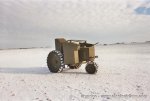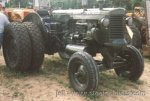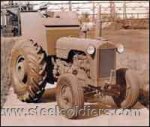RE: tractors
Here is a link for a JD "A" with twin 30 cal guns:
http://www.knapptedesco.com/tank.htm
Check out the power point presentation if you can, it is neat. The dis-advantages for production are pretty funny! I will post the article contents here for posterity:
John Deere Co. Built the Armored A Tank in 1941 and sent it to the Aberdeen Proving Grounds in Maryland to be tested for combat for WWII.
The primary purpose of the tank was that John Deere design and manufacture this armored tractor to provide a low priced combat unit in volume lots.
The three major uses of the tank were to be used as a combat unit, to be used as an armored prime mover, and as a trainer for tank operators.
The objective of the Aberdeen test was to determine the military suitability of the tractor, to determine where the tractor could be fitted into the military program, to determine the feasibility of towing the tractor on a trailer behind a truck prime mover, and to determine the military suitability of the tractor-trailer for the handling of supplies.
The following is a portion of the original letter from Aberdeen Proving Ground dated 2/19/1941.
1. The test of the John Deere Model "A" Armored Tractor was authorized by letter 0.0. 451.22/371, dated January 10, 1941. The unit was tested late January to early Februrary 1941. Throughout the complete test, the determination of military suitability was stressed. No attempts was made to suggest extensive development work in the basic tractor which would increase the military suitability as any major changes in the tractor would deviate from the apparent original purpose of the manufacturer: that is, to provide a low-priced combat unit which would be quickly available in volume lots. The manufacturer's representative states that, under existing conditions, his firm is capable of building one hundred (100) tractors per day, but with no provision for the furnishing of armor plate. The declared purpose of the trailer is primarily to carry the tractor quickly at high speeds over hard-surfaced roads behind a wheeled prime mover or truck; this trailer can also be used to carry ammunition or other supplies forward on the battlefield.
2. The present tractor is not suitable as a machine gun combat unit because it does not have sufficient maneuverability; that is, due to the dual-wheeled front, castor unit the vehicle will not steer in deep sand or mud. However, with a minor modification of the front wheel assembly, the unit could be used as an armored prime mover or as an improvised light tank.
3. The approximate weight of the bare tractor is 5500 pounds. Approximately 3500 pounds of steel plate (simulating armor plate), which varies in thickness from 3/16 inch to 3/8 inch, has been added. The cost of the tractor itself would not exceed $2000; with the cost of fabricated armor plate at about $1.00 per pound, the gross cost of the unit would be approximately $6500.00 - $8000.00 (depending on the degree of refinement of the design, instruments and changes, excluding machine guns).
4. The following are some of the disadvantages were found in the vehicle tested:
a. Too low a horsepower per weight ratio; approximately seven (7) horsepower per ton.
Results of Aberdeen Testing
b. Poor visibility - The visible area starts ten (10) feet from the tractor on either side of the engine hood; at this distance, it is two (2) feet wide and tapers to a width of fifteen (15) feet at fifty (50) feet ahead of the tractor. The poor visibility is in part responsible for the rough riding, due to inability to see obstructions in the immediate foreground. (Reference memorandum dated 17 February, 1941, inclosed).
c. Rough riding qualities - such as to be expected in any unsprung vehicle; rougher than a Light Tank M2A4.
d. Poor maneuverability - largely due to the construction of the front axle castor.
e. Type of engine - The engine is of the two-cylinder type. This engine is inferior for a combat vehicle.
Some other disadvantages were:
a. Machine guns shot out the tires.
b. Not enough room for 30 calibar ammo boxes.
c. Too much weight for a John Deere Tractor.
d. Top heavy.
e. When the machine guns were pointed near the driver, it was defening for the driver.
f. The stering wheel would go out of control when the tank hit a pot hole.
g. Gunner had very poor visability and could n't steady the machine guns when traveling over rough terrain.
h. Gunners would be burned by hot 30 cal. shells.
5. Advantages:
a. Relatively low cost.
b. Quick availability.
c. Readily obtainable in quantity.
6 A vehicle such as this can obviously not compete with a specially-developed fighting machine such as a light tank and under normal conditions would probably be unacceptable as an item of equipment. However, circumstances could readily arise where the ready availability of this vehicle would be of great value to the Army for the following uses:
a. For use until production of specially designed tanks is available.
b. For use in secondary campaigns.
c. For use in training.
Fate of the original tractor tank is unknown.





